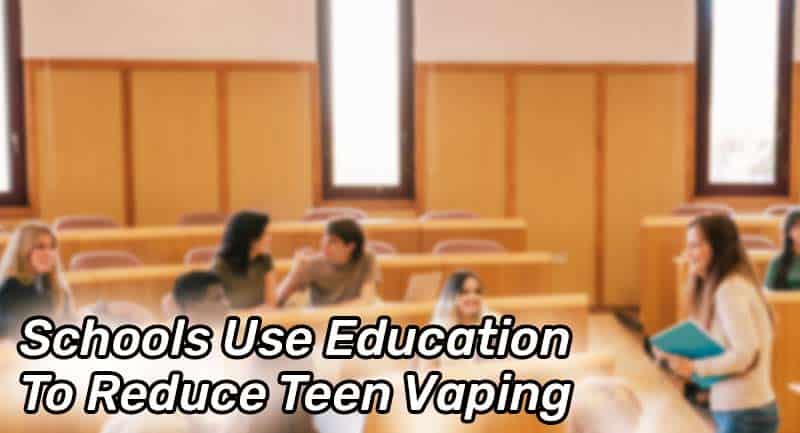The rising trend of electronic cigarette use, commonly known as vaping, among teenagers has become a significant concern for parents, educators, and health professionals alike.
This risky behavior not only poses serious health risks but also brings about addictive habits that can persist into adulthood. In response to this alarming issue, schools across the globe are stepping up their efforts to help prevent teens from starting vaping.
Through a multifaceted approach involving education, intervention, and support systems, schools are determined to empower students with the knowledge and resilience needed to resist the temptations of this dangerous habit.
Understanding the Vaping Epidemic
Vaping involves inhaling and exhaling aerosol produced by an electronic device known as an e-cigarette.
Many teenagers are drawn to vaping due to factors such as peer influence, a misperception of it being a safe alternative to traditional smoking, and the flavors often marketed to appeal to youthful tastes.
Unfortunately, the truth is far more sinister. Vaping exposes adolescents to high levels of nicotine, harmful chemicals, and potentially dangerous additives that can have detrimental effects on their physical and mental well-being.
Education: The First Line of Defense

One of the key strategies schools employ to combat teen vaping is to provide comprehensive education about the dangers and consequences of this habit.
By educating students about the risks associated with vaping, schools aim to equip them with essential knowledge that will deter them from experimenting with e-cigarettes.
The education process can take various forms, including classroom lessons, seminars, guest speaker sessions, and informational campaigns.
Some school districts have even incorporated vaping-related curriculum into health classes as part of a broader effort to address substance abuse.
During these sessions, several critical aspects are covered:
- Nicotine Addiction: Students learn about the addictive nature of nicotine found in e-cigarettes and the potential long-term consequences of addiction. They are educated about withdrawal symptoms and the challenges faced by those trying to quit nicotine dependency.
- Health Risks: Students are informed about the ill effects vaping has on the respiratory system, including lung damage and an increased risk of respiratory diseases. Additionally, they learn about potential cardiovascular issues, such as increased heart rate and blood pressure, and the impact these factors can have on their overall well-being.
- Chemical Exposure: Schools emphasize the harmful chemicals present in e-cigarette aerosol and the potential risks associated with inhaling them. This includes substances like formaldehyde, acrolein, and volatile organic compounds that can damage lung tissue and lead to chronic diseases.
- Misleading Marketing Tactics: Students are made aware of the manipulative marketing strategies used by the vaping industry to allure young consumers. They learn to recognize how companies strategically target their products to appeal to teenagers by offering enticing flavors and sleek designs.
- Establishing Healthy Coping Mechanisms: Schools encourage students to identify healthier alternatives to manage stress and peer pressure, such as engaging in physical activity, practicing mindfulness, or pursuing creative outlets. Empowering students with positive coping mechanisms reduces their vulnerability to resorting to vaping as an escape.
Intervention and Support Systems
Recognizing the importance of intervention and support, schools implement various measures to identify and help students who may already be vaping or at risk of starting. These interventions aim to provide individual assistance, create a supportive environment, and facilitate healthier choices.
- Counseling Services: Schools often employ professional counselors who are proficient in addressing substance abuse issues. These counselors are trained to identify signs of teenage vaping and provide the necessary support, guidance, and resources to those involved. Providing a safe and confidential space for students to express their concerns and seek help can be crucial in preventing further escalation.
- Peer Mentoring Programs: By pairing older students who have successfully refrained from engaging in vaping with younger students, schools establish strong peer mentoring systems. These programs promote positive role models and create a platform where students can freely discuss their concerns, seek advice, and receive guidance from their peers, who can relate to and understand their struggles.
- Enforcing Clear Policies: Schools play a pivotal role in setting clear expectations surrounding vaping. They establish and enforce strict policies that prohibit the use of e-cigarettes on school premises and during school-sponsored events or activities. By implementing consequences for violations, schools send a strong message that vaping is unacceptable, ensuring a healthier environment for all students. Compliance is further enforced through the use of a vape detector in each room of the school.
- Parental Involvement: Schools actively engage parents and guardians in their efforts to prevent teen vaping. Regular communication, educational workshops, and resources are provided to help parents recognize the signs of vaping and equip them with tools to address the issue at home. Parents are encouraged to have open discussions about the subject with their teenagers, reinforcing the dangers and consequences of vaping and supporting healthy lifestyle choices.
As the prevalence of teen vaping continues to rise, schools are becoming increasingly proactive in implementing strategies designed to combat this harmful trend.
By prioritizing comprehensive education, intervention, and support systems, schools aim to create an environment that empowers students to make well-informed choices regarding their health.
Together, parents, educators, and communities can work collaboratively to curb teen vaping, ultimately ensuring a healthier future for today’s youth.
